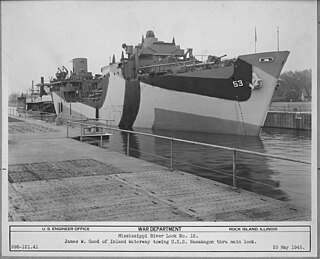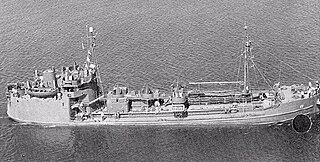Four ships of the United States Navy have been named USS or USNS Susquehanna, for the Susquehanna River which rises in Lake Otsego in central New York and flows across Pennsylvania and the northeastern corner of Maryland into the Chesapeake Bay, which is the flooded estuary of that river.

USS Patapsco (AOG–1) was a Patapsco-class gasoline tanker of the United States Navy, and the lead ship of her class. She saw service during World War II, the Korean War and the Vietnam War. Patapsco was the sixth ship of the US Navy to be named for the Patapsco River in Maryland. After decommissioning she was converted to a fishing vessel under the name Arctic Storm, and is currently in operation.

USS Namakagon (AOG-53) was a Patapsco-class gasoline tanker built for the United States Navy during World War II. In some sources, the ship's name is also spelled Namakogon. After her decommissioning from the U.S. Navy in 1957, the former Namakagon served as Antarctic supply vessel HMNZS Endeavour (A184) for the Royal New Zealand Navy (1962–1971), and as ROCS Lung Chuan for the Republic of China Navy. Lung Chuan ended active service when she was decommissioned from the Republic of China Navy in 2005.

USS Wabash (AOG-4) was a Patapsco-class gasoline tanker acquired by the U.S. Navy for the dangerous task of transporting gasoline to warships in the fleet, and to remote Navy stations.

The Patapsco class of gasoline tankers were a class of tankers built for the United States Navy during World War II. The class consisted of 23 tankers, designated AOG-1 through AOG-11, and AOG-48 to AOG-59. They served through the Korean War and several served in foreign navies.

USS Wacissa (AOG-59) was a Patapsco-class gasoline tanker delivered to the United States Navy in 1946. She directly put in reserve and reactivated for service with the Military Sea Transportation Service between 1952 and 1956. In 1957, she was transferred to the United States Air Force. Shortly thereafter she was again transferred to Canada. She was finally scrapped in 1964.

USS Kern (AOG-2) was a Patapsco-class gasoline tanker acquired by the United States Navy for the dangerous task of transporting gasoline to warships in the fleet, and to remote Navy stations.

USS Rio Grande (AOG-3) was aPatapsco-class gasoline tanker in service with the United States Navy from 1943–1946 and 1950–1956. She was scrapped in 1972.

USS Agawam (AOG-6) was a Patapsco-class gasoline tanker acquired by the U.S. Navy for the dangerous task of transporting gasoline to warships in the fleet, and to remote Navy stations.

USS Elkhorn (AOG-7) was a Patapsco-class gasoline tanker in service with the U.S. Navy from 1944 to 1972. She was then sold to Taiwan, where she served as ROCS Hsing Lung (AOG-515/AOG-517). Her final fate is unknown.

USS Kishwaukee (AOG-9) was a Patapsco-class gasoline tanker acquired by the U.S. Navy for the task of transporting gasoline to warships in the fleet, and to remote Navy stations.

USS Nemasket (AOG-10) was a Patapsco-class gasoline tanker in service with the U.S. Navy from 1944 to 1959. She was scrapped in 2006.

USS Chehalis (AOG-48) was a Patapsco-class gasoline tanker acquired by the United States Navy for the dangerous task of transporting gasoline to warships in the fleet, and to remote Navy stations. The vessel was named after the Chehalis River located in Washington state.
At least two ships of the United States Navy have borne the name USS Chehalis.

USS Chewaucan (AOG-50) was a Patapsco-class gasoline tanker in service with the United States Navy from 1945 to 1975. She was then transferred to the Colombian Navy, her final disposition being unknown.

USS Mattabesset (AOG-52) was a Patapsco-class gasoline tanker in service with the United States Navy from 1945 to 1968. She was scrapped in 1969.

USS Pecatonica (AOG-57) was a Patapsco-class gasoline tanker in service with the United States Navy from 1945 to 1946 and from 1948 to 1961. She was then transferred to the Taiwanese Navy where she served as ROCS Chang Pei (AOG-307/AOG-507) until 2005.

The T1 tanker or T1 are a class of sea worthy small tanker ships used to transport fuel oil before and during World War II, Korean War and Vietnam War. The T1 tanker classification is still in use today. T1 tankers are about 200 to 250 feet in length and are able to sustain a top speed of about 12 knots. The hull designation AO is used by the US Navy to denote the ship is a T1 oil tanker and AOG that the T1 is a gasoline tanker. The small size allows the T1 to enter just about any sea port or to anchor around a small island, this was very useful during the Pacific War. The T1 tanker can carry about 48,000 to 280,000 bbls. Some T1 tankers were used to transport goods other than oil, a few were used for black oil-crude oil, diesel, chemicals and rarely bulk cargo like grain. T1 tankers are also called liquid cargo carriers. The T1 tanker has about a 6,000 to 35,000 deadweight tonnage (DWT) of cargo. The small size also gives the ships short turn around time for repair, cleaning, loading and unloading. A T1 tanker carrying dirty cargo, like crude oil needs a few weeks of labor to clean before carrying clean cargo. Most T1 ships during World War II were named after major oil fields.

USS Klickitat (AOG-64), was the lead ship of the type T1 Klickitat-class gasoline tanker built for the US Navy during World War II. She was named after the Klickitat River, in Washington.
This page is based on this
Wikipedia article Text is available under the
CC BY-SA 4.0 license; additional terms may apply.
Images, videos and audio are available under their respective licenses.















